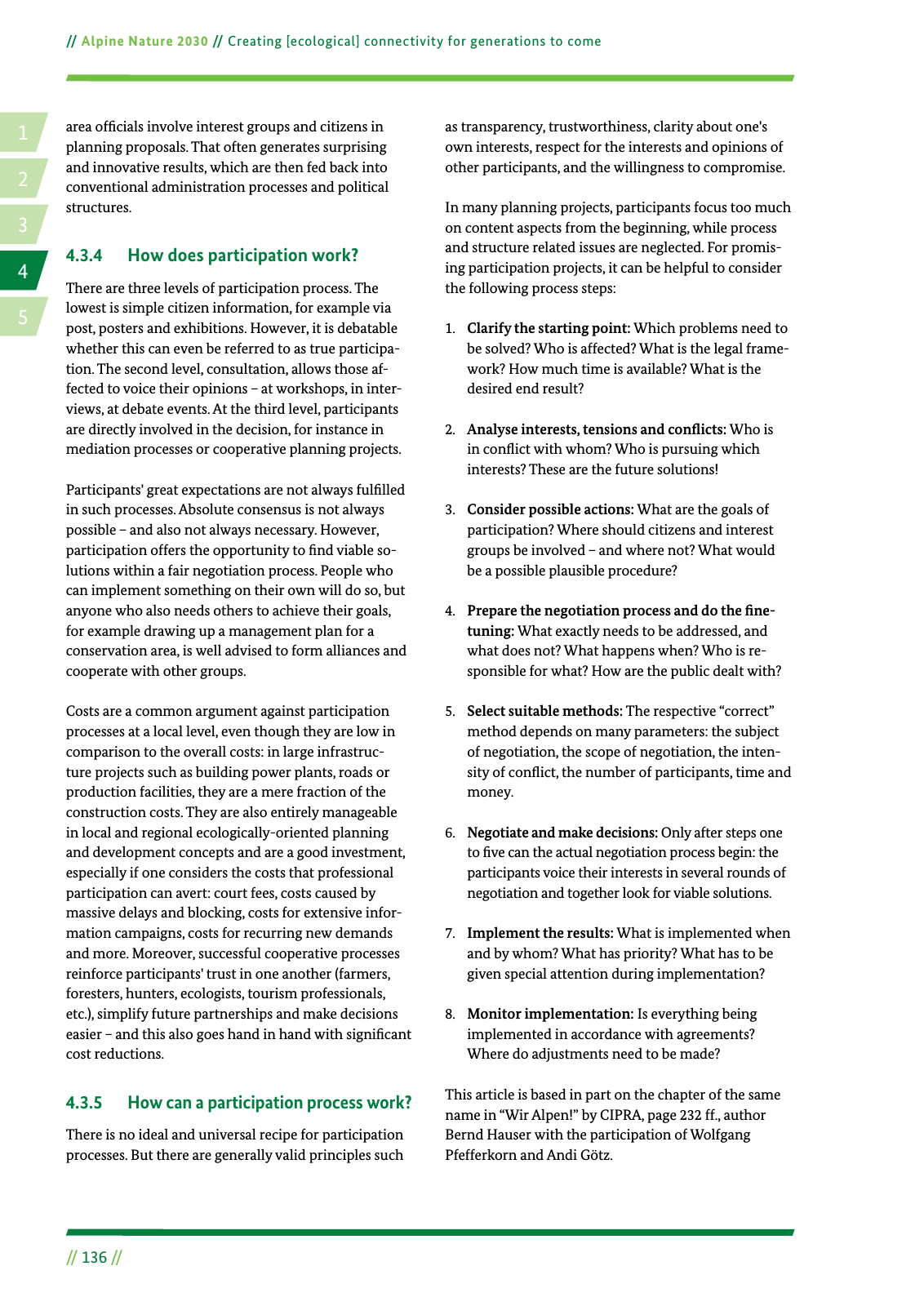14 2 5 3 Alpine Nature 2030 Creating ecological connectivity for generations to come 136 area of cials involve interest groups and citizens in planning proposals That often generates surprising and innovative results which are then fed back into conventional administration processes and political structures 4 3 4 How does participation work There are three levels of participation process The lowest is simple citizen information for example via post posters and exhibitions However it is debatable whether this can even be referred to as true participa tion The second level consultation allows those af fected to voice their opinions at workshops in inter views at debate events At the third level participants are directly involved in the decision for instance in mediation processes or cooperative planning projects Participants great expectations are not always ful lled in such processes Absolute consensus is not always possible and also not always necessary However participation offers the opportunity to nd viable so lutions within a fair negotiation process People who can implement something on their own will do so but anyone who also needs others to achieve their goals for example drawing up a management plan for a conservation area is well advised to form alliances and cooperate with other groups Costs are a common argument against participation processes at a local level even though they are low in comparison to the overall costs in large infrastruc ture projects such as building power plants roads or production facilities they are a mere fraction of the construction costs They are also entirely manageable in local and regional ecologically oriented planning and development concepts and are a good investment especially if one considers the costs that professional participation can avert court fees costs caused by massive delays and blocking costs for extensive infor mation campaigns costs for recurring new demands and more Moreover successful cooperative processes reinforce participants trust in one another farmers foresters hunters ecologists tourism professionals etc simplify future partnerships and make decisions easier and this also goes hand in hand with signi cant cost reductions 4 3 5 How can a participation process work There is no ideal and universal recipe for participation processes But there are generally valid principles such as transparency trustworthiness clarity about one s own interests respect for the interests and opinions of other participants and the willingness to compromise In many planning projects participants focus too much on content aspects from the beginning while process and structure related issues are neglected For promis ing participation projects it can be helpful to consider the following process steps 1 Clarify the starting point Which problems need to be solved Who is affected What is the legal frame work How much time is available What is the desired end result 2 Analyse interests tensions and con icts Who is in con ict with whom Who is pursuing which interests These are the future solutions 3 Consider possible actions What are the goals of participation Where should citizens and interest groups be involved and where not What would be a possible plausible procedure 4 Prepare the negotiation process and do the ne tuning What exactly needs to be addressed and what does not What happens when Who is re sponsible for what How are the public dealt with 5 Select suitable methods The respective correct method depends on many parameters the subject of negotiation the scope of negotiation the inten sity of con ict the number of participants time and money 6 Negotiate and make decisions Only after steps one to ve can the actual negotiation process begin the participants voice their interests in several rounds of negotiation and together look for viable solutions 7 Implement the results What is implemented when and by whom What has priority What has to be given special attention during implementation 8 Monitor implementation Is everything being implemented in accordance with agreements Where do adjustments need to be made This article is based in part on the chapter of the same name in Wir Alpen by CIPRA page 232 ff author Bernd Hauser with the participation of Wolfgang Pfefferkorn and Andi Götz

Hinweis: Dies ist eine maschinenlesbare No-Flash Ansicht.
Klicken Sie hier um zur Online-Version zu gelangen.
Klicken Sie hier um zur Online-Version zu gelangen.